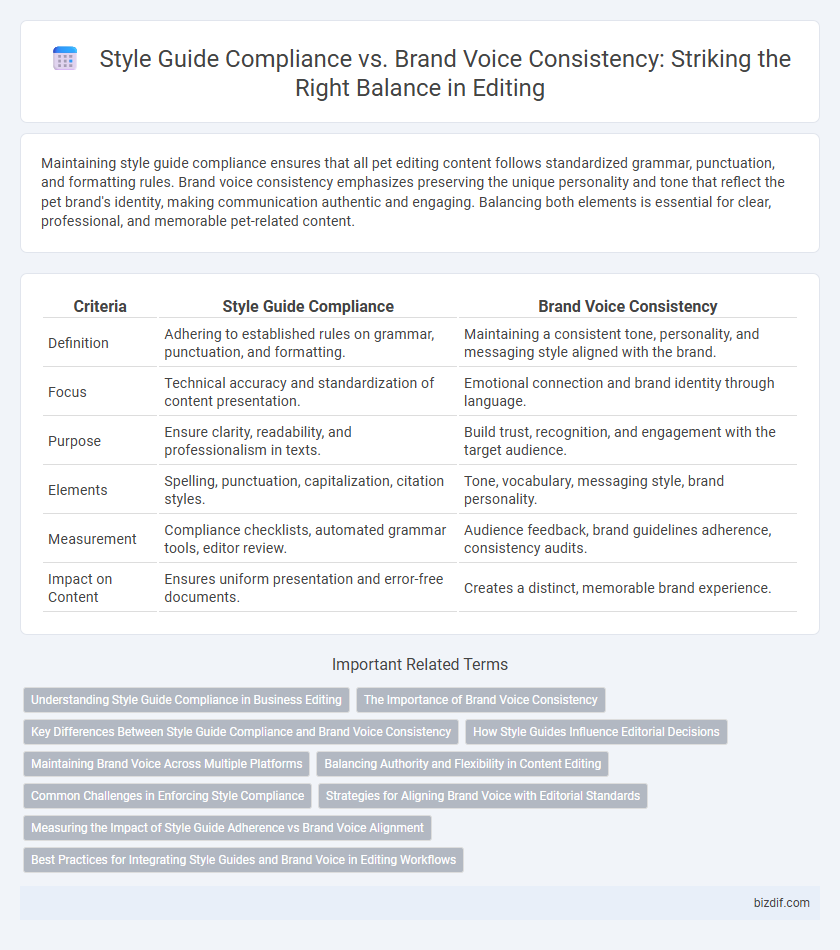Maintaining style guide compliance ensures that all pet editing content follows standardized grammar, punctuation, and formatting rules. Brand voice consistency emphasizes preserving the unique personality and tone that reflect the pet brand's identity, making communication authentic and engaging. Balancing both elements is essential for clear, professional, and memorable pet-related content.
Table of Comparison
| Criteria | Style Guide Compliance | Brand Voice Consistency |
|---|---|---|
| Definition | Adhering to established rules on grammar, punctuation, and formatting. | Maintaining a consistent tone, personality, and messaging style aligned with the brand. |
| Focus | Technical accuracy and standardization of content presentation. | Emotional connection and brand identity through language. |
| Purpose | Ensure clarity, readability, and professionalism in texts. | Build trust, recognition, and engagement with the target audience. |
| Elements | Spelling, punctuation, capitalization, citation styles. | Tone, vocabulary, messaging style, brand personality. |
| Measurement | Compliance checklists, automated grammar tools, editor review. | Audience feedback, brand guidelines adherence, consistency audits. |
| Impact on Content | Ensures uniform presentation and error-free documents. | Creates a distinct, memorable brand experience. |
Understanding Style Guide Compliance in Business Editing
Style Guide Compliance in business editing ensures adherence to predefined rules for grammar, punctuation, and formatting, fostering clarity and professionalism across all corporate communications. This compliance supports consistency in documents, enhancing readability and reducing misunderstandings. Rigorous application of style guides like AP, Chicago, or internal corporate manuals is essential for maintaining the company's credibility and legal integrity.
The Importance of Brand Voice Consistency
Brand voice consistency ensures all communications reflect the company's core values and personality, fostering trust and recognition among the target audience. Maintaining a unified tone across platforms strengthens emotional connections with customers, differentiating a brand in competitive markets. Adhering strictly to a style guide without preserving the distinct brand voice can dilute the brand's identity and reduce engagement effectiveness.
Key Differences Between Style Guide Compliance and Brand Voice Consistency
Style guide compliance ensures all content adheres to specific rules on grammar, punctuation, and formatting, maintaining uniformity across all communications. Brand voice consistency focuses on preserving the unique personality, tone, and emotional impact that aligns with the brand's identity and resonates with its target audience. While style guides address technical accuracy, brand voice consistency drives emotional connection and differentiation in the marketplace.
How Style Guides Influence Editorial Decisions
Style guides provide structured rules for grammar, punctuation, and formatting that ensure uniformity across all editorial content, directly influencing editorial decisions by setting clear standards. Brand voice consistency emphasizes the tone, personality, and emotional resonance of content, guiding editors to maintain a cohesive message that aligns with brand identity. Together, style guides and brand voice directives shape editorial choices, balancing technical correctness with authentic communication.
Maintaining Brand Voice Across Multiple Platforms
Maintaining brand voice consistency across multiple platforms ensures cohesive messaging that strengthens brand identity and customer recognition. Adhering to a style guide provides standardized rules for grammar, punctuation, and formatting, but brand voice focuses on tone, personality, and emotional connection tailored to each platform's audience. Balancing style guide compliance with flexible brand voice adaptation enables effective communication while preserving authenticity and engagement.
Balancing Authority and Flexibility in Content Editing
Balancing style guide compliance and brand voice consistency ensures content maintains authoritative credibility while allowing creative flexibility. Editors must enforce established grammar, punctuation, and formatting standards while adapting tone and language to resonate authentically with the target audience. This approach enhances brand identity without stifling unique expression, fostering both trust and engagement.
Common Challenges in Enforcing Style Compliance
Maintaining style guide compliance often conflicts with preserving brand voice consistency due to varying interpretations of tone and language rules among editors. Common challenges include subjective judgment calls, inconsistent enforcement across teams, and balancing strict adherence to technical guidelines with the creative flexibility needed for authentic brand expression. These issues can result in fragmented messaging and dilute the impact of content across different channels.
Strategies for Aligning Brand Voice with Editorial Standards
Aligning brand voice with editorial standards requires developing a comprehensive style guide that integrates brand personality traits and tone preferences. Regular training sessions and detailed documentation ensure editors consistently apply these guidelines across all content types. Utilizing feedback loops and analytics helps refine the alignment, maintaining both style guide compliance and authentic brand voice expression.
Measuring the Impact of Style Guide Adherence vs Brand Voice Alignment
Measuring the impact of style guide adherence involves assessing uniformity in grammar, punctuation, and formatting to ensure clarity and professionalism. Brand voice alignment evaluates how well content reflects the organization's personality, tone, and values to foster audience connection and loyalty. Combining quantitative metrics like error rates and audience engagement data reveals the effectiveness of maintaining both style guide compliance and brand voice consistency in content editing.
Best Practices for Integrating Style Guides and Brand Voice in Editing Workflows
Integrating style guide compliance with brand voice consistency requires establishing clear editorial frameworks that balance standardized language rules and the unique tonal elements of the brand. Effective editing workflows incorporate collaborative tools and regular training sessions, ensuring editors align grammar, punctuation, and formatting standards with the brand's personality and messaging. Leveraging technology such as AI-driven content analysis enhances accuracy and maintains consistency across all digital and print communications.
Style Guide Compliance vs Brand Voice Consistency Infographic

 bizdif.com
bizdif.com